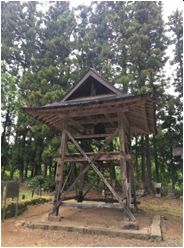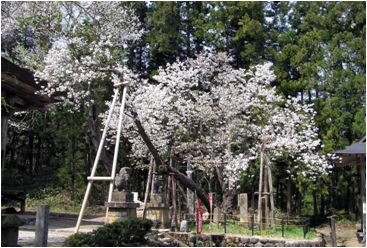
養老四年(720)徳道上人により建立された、会津の中でも最古級の寺。
僧・徳一が恵日寺を開くまでは、会津仏教文化の中枢と言える程栄えていた。
日本遺産 平成28年度認定

Houyoji Zushi and Butsudan Shrines
- National Designated Important Cultural Property
- Designated on June 9, 1960
It is a Sanken Zushi (altar), enshrined in the main hall (Kannon-do Hall) is Zenshu-yo architecture.
There is an inscription of building bill of the Kamakura period (1314), and that is the oldest memorial inscription in Aizu. In addition, the pattern of bats in the parapet is unusual.
Aizumisato Town Board of Education

Wooden Standing Statue of Kongourikishi
- National Designated Important Cultural Property
- Designated on June 9, 1960
- Agyou 224.0 cm
- Ungyou 216.0 cm
Wooden Standing Statue of Kongourikishi is originally a statue of Yasha with a golden vajra, and the two bodies of Agyou and Ungyou form a line to protect the temple gate. Therefore, it is also called Nio (two kings).
The two statues of this temple are carved using one Japanese zelkova for each (called Ichiboku-zukuri), though they are colossi over 2 meters. The appearance of the anger, and the way in which the muscles and clothes appear, are full of power, but they are not exaggerated. The disposition of arms and the twisting of the lower back are arranged in a strong figure that has the power inside.
As the statue of Kongourikishi in Fujiwara period, not only in Fukushima Prefecture, but there are few similar cases nationwide. Along with the statue of Bujouji Temple in Kyoto, both of them are excellent items.
Aizumisato Town Board of Education

Houyoji Temple Triple Tower
- Fukushima prefecture designated important cultural property
- Designated date: March 28, 1980
- Address: Sanbanyamashita-3554 Suzumebayashi, Aizumisato Town, Onuma District, Fukushima
- Owner: Houyoji temple
- Wooden, three-layer building (Hogyo-zukuri), Roof with copper plate (Motokokera-Itabuki),
- Land Area: 29.8㎡(Housangen)
The only tower remains that exist in the Aizu region. It is a Zen sect style architecture and features a deep eaves.
There are no bills indicating the age of construction, but in the second layer, there is a blueprint drawn in 1768.
According to the historical records, it was completed in 1780 with the start of construction in 1772. It is said that it has been rebuilt twice since the foundation of the temple.
In the first layer, an altar is built on the inside and the three of Buddha are enshrined in it.
Fukushima Prefectural Board of Education

Kannon-Do
This temple was founded in 720 by the Buddhist priest Shonin Tokudo. Before the Buddhist priest Tokuitsu built Enichiji Temple, and spread Buddhism throughout Aizu, it was the center of Buddhist culture in the area.
In 807, this hall and statue were destroyed in a fire, but Tokuitsu later rebuilt it in its current location.The Kannon has eleven-faces which peer out in all directions, and two bodies.
This two- bodied statue is the principal deity of the Kannon-do hall, worshiped by the people of the region. Though the statue itself was slightly burned, it is still worshiped today.
Wooden Eleven-faced Kannon Statue [Katsura・Zelkova tree]
- Fukushima prefecture designated important cultural property
- Designated date: December 10, 1968
- Owner: Houyoji temple
- There are two kinds of Katsura and Japanese zelkova. Both are carved in one wood
The statue of Katsura is not hollow. The necklace and chest decoration are all calligraphy. The image height is 147.5cm, pedestal 33.5cm.
The statue of Japanese zelkova is colored after generations, and the original appearance is hard to catch. The image height is 154.5cm, pedestal 16cm. Both statues are the work of the early Fujiwara period.
Aizumisato Town Board of Education
Wooden Seated Statue “Tokudo-Shonin”
- Fukushima prefecture designated important cultural property
- Owner: Houyoji temple
- Designated date: December 10, 1968
It is an image of a great monk who opened the Houyoji temple in 720. The skin is covered with linen and finished with black lacquer. It is a yosegi-zukuri style, eyes are made of crystal. A work of the end of the Kamakura period. The image height is 87.5 cm.
Aizumisato Town Board of Education

Bronze Bell
- Fukushima prefecture designated important cultural property
- Owner: Houyoji temple
- Designated date: December 27, 1955
It is a large bell with a total height of 104.53 cm and a diameter of 75.75 cm. Carved in 1474. It is said to have been cast by a joint work between founder “Echigonokuni Myojitsu” and Hidama’s (current Aizu Hongomachi) founders.
Aizumisato Town Board of Education
Eleven Face Kannon Hangi (Carved on the Board)
- Fukushima prefecture designated important cultural property
- Owner: Houyoji temple
- Designated date: April 13, 1971
Eleven-faced Kannon Bosatsu stature is carved delicately on the wooden board, 62.3 cm high, 30 cm wide, and 1.7cm thick. On the left side of the stature, “Principal image of Buddha in Raidensan Houyoji” is engraved. On the right is engraved “1397”.
This Kannon is carved the Hasedera-style. The origin stature in Hasedera temple and in Shidoji temple has been lost. Now, this board is very valuable as the board engraved in early Muromachi period to keep the ancient prototype.
Aizumisato Town Board of Education

Tora no O Zakura (Cherry Blossoms like Tiger’s Tail)
Aizumisato Town Designated Natural Monument
Designated date: April 1, 1971
It is said that the name originates from its shape of stamen petalized which resembles a tiger’s tail. It is one of the Aizu 5 cherry blossoms. The time of bloom is about late April.
March, 2018
Aizumisato Town Board of Education
